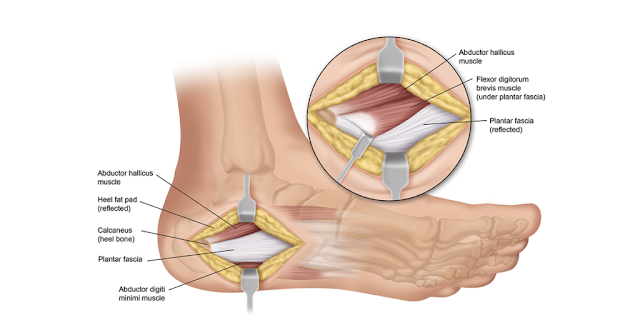Have you ever experienced a stabbing pain in your heel when you step out of your bed in the morning? Then the pain decreases with usual walking and it strikes again when you stand for a long time. This pain is referred to as Plantar Fasciitis.
Research says that more than 50% of Americans experience heal pain and the most common condition is Plantar Fasciitis.
Plantar Fasciitis is caused due to too much strain on the plantar fascia which is a ligament that connects the heel to the toes. It results in pain and inflammation.
The plantar fascia is in the shape of a bowstring that supports the arch of your foot and absorbs shock when you perform activities such as walking, running, or standing. While doing so, tension or stress on the bowstring can cause the plantar fascia to experience tears. When tearing occurs repeatedly, it causes inflammation in the fascia which leads to heel pain.
Runners and pregnant women are the most common ones affected by this type of pain. People who are overweight also experience heel pain as the extra pounds put more pressure on the plantar fascia. Those who work for long hours by standing or walking have a high risk of getting plantar fasciitis.
How Is It Diagnosed?
Plantar fasciitis is diagnosed based on your medical history. The physician might carry out a physical examination to check the areas of tenderness in the foot. The location of the pain will help the physician determine the reason for heel pain.
In addition, you may undergo X-Rays and MRI scan to determine whether your heel pain is caused due to any other conditions.
If you ignore plantar fasciitis, the
inflammation might become worse and lead to chronic heel pain. The strength and
stability of the ligament get affected which might be a hindrance for
performing your daily activities with ease.
Physical Therapy Treatment Methods
Your physician might recommend you to
consult a physical therapist who may treat you with Transcutaneous Electrical
Nerve Stimulation and five minutes of low-level infrared energy treatment along
with the Kinesio taping method. Your therapist might also recommend some
stretches.
1) Transcutaneous Electrical Nerve
Stimulation (TENS) Method
TENS unit consists of a battery-powered device that sends electrical impulses through the electrodes that are adhered to the area experiencing pain.
To treat plantar fasciitis, electrodes are placed to the feet that deliver low voltage electrical current. It causes the muscles in the feet and legs to contract and release at intervals thus activating the natural pain relief mechanism.
The electric impulses stimulate the nerve tissues in the feet to block the transfer of pain signals thereby changing the sense of pain. It also improves the number of endorphins which are the human body’s natural painkillers.
The TENS devices used to treat plantar
fasciitis is designed in three different shapes. One form looks like a pair of
sandals that you slip onto your feet, the other one looks like a small platform
that you place your feet on and the third design looks like a phone with
electrodes attached to it.
2) Infrared Energy Treatment
Using infrared energy is a good treatment option since it is completely painless, non-invasive, and has no side effects. This method is performed by applying infrared light over the feet that penetrates deep into tissues and impacts the ligaments, tendons, nerves and connective tissues.
This method speeds up the healing
process by reducing inflammation and pain. It is effective in curing both
chronic and acute heel pain.
3) Kinesio Taping Method
Kinesiology taping is one of the most effective methods to treat plantar fasciitis as it helps to increase blood flow in the feet and reduces inflammation thereby speeding up the healing process.
A zinc oxide tape that provides more rigidness when compared to other tapes is preferred to treat plantar fasciitis. This tape is durable, water-resistant, and gentle on your skin.
Your physical therapist might help you to apply the kinesiology tape effectively.
Steps to apply Kinesio tape properly:
1) Clean and dry the feet before you
apply the tape.
2) Position your foot out in front of
you and wrap the tape around your foot.
3) Apply a strip of tape to the bottom
of your foot.
4) Apply a second strip around the back
of your heel. Pull the ends of the strips across the sole of your foot and
again to the ball of your foot to form an X shape.
5) Repeat this step with each strip slightly overlapping the previous one for maximum support.
Kinesiology taping
can reduce the amount of stretching and moving that the ligament performs while
on your feet. It improves the chances of healing and prevents further injury.
Final Thoughts
Your therapist might suggest some
stretches like stretching your calves, stretching the plantar fascia, rolling
stretch, marble pickups, and foot flexes to make the treatment more effective.
You must note that TENS alone or Kinesio taping alone could not heal the pain.
These treatments can reduce the pain and when done together can help you to get
rid of plantar fasciitis. Feel free to contact us or book an
appointment today at Step Ahead Physical Therapy.










0 Comments